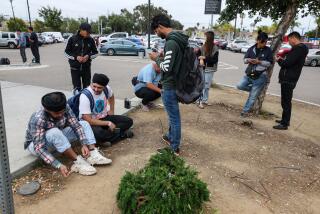Q&A; : GTE Launches Controversial Caller ID in State Today
- Share via
The controversial telephone service known as Caller ID will begin today for millions of GTE customers in California, although it won’t be available for the majority of phone users for several weeks as Pacific Bell straightens out a snafu that caused inaccurate letters to be sent to some of its customers.
One day after winning final approval from state regulators to begin offering the service today, Pacific Bell decided on Friday to delay implementation of Caller ID on the 15 million phone lines it serves in the state. An undetermined number of Pacific Bell customers, who requested that their lines be fully blocked, accidentally received letters stating that they would receive the opposite service. Pac Bell said it was still determining the cause and extent of the problem.
“We do not intend to launch Caller ID service until we are certain our customers’ blocking requests have been correctly registered,” said Mark Pitchford, Pacific Bell’s vice president for consumer marketing. “We have received calls from customers who are concerned, and that concerns us.”
GTE customers will not be affected by Pacific Bell’s delay. Phone numbers of the two-thirds of GTE customers who did not request per-line blocking will now be sent out as they make calls around the country.
Here are some answers to common questions about Caller ID:
Q. What is Caller ID?
A. Customers who buy Caller ID services will be able to see the phone numbers of the people who are calling them on a digital display. This could make it easier for people to screen their calls because they can see who is on the line before deciding whether to answer the phone--much like looking through a peephole to see who is knocking on the door.
Businesses can use Caller ID to compile lists of phone numbers of customers and potential customers. Such lists are valuable to telemarketers who make sales pitches over the phone. To protect their privacy and conceal their identity from businesses, a substantial number of California phone customers have opted to have their phone lines blocked so that their numbers won’t be revealed to the people they call. Telemarketers may also use blocking options so that when they make calls, they won’t be identified and shunned.
*
Q. How does it work?
A. People who want Caller ID will have to order it from their phone company. It is being sold like call waiting, call return and other optional services.
Even those who don’t buy the service have to make a decision about Caller ID. Those who order Selective Blocking--in which the phone number is sent unless a call is specifically blocked--or do nothing will have their phone numbers sent out automatically on every call they make. They can still block their numbers for free on an individual basis by dialing *67 before placing a call. The other option is to request Per-Line Blocking, which means the number will not be sent out unless the caller dials *82 first. People with rotary phones can dial 1167 and 1182.
*
Q. How will this affect my privacy?
A. Caller ID has the potential to both enhance and diminish one’s privacy.
Those concerned that it will diminish privacy point to the case of a San Antonio woman who was shot to death last year by her ex-boyfriend, who used Caller ID to determine her whereabouts. While that case is as rare as it is tragic, some are concerned that battered women and other victims will find it tougher to hide from their abusers with the introduction of Caller ID.
People with unlisted numbers who do not ask for blocking will also be losing some of the benefits of not being in the phone book. On the other hand, Caller ID can enhance one’s privacy when used as a tool to screen calls.
*
Q. I requested Per-Line Blocking with Pacific Bell. Will my number be protected?
A. You should call (800) 386-0000 from the line that should be blocked to verify that the request was correctly processed. You can also call (800) 298-5000 to talk with a customer service operator. Until you are sure that you have Per-Line Blocking, Pac Bell recommends you dial *67 before placing your calls.
*
Q. Why have there been so many delays?
A. New Jersey became the first state to authorize Caller ID in 1987, and other states have steadily followed. But California held out because of concerns over privacy in a state where more than half of the residents have unlisted phone numbers.
Recognizing those privacy concerns, the state Public Utilities Commission decided to allow phone companies to bring Caller ID to California with the proviso that customers’ phone numbers be automatically concealed unless they take specific action to unblock their lines. But the Federal Communications Commission said that rule was too stringent and eventually won out in a court battle. The PUC then ordered the phone companies to conduct a massive public education campaign to make customers aware of their blocking options before they could offer the service.
Pacific Bell was initially scheduled to begin offering Caller ID on June 1. But last month, the company announced it would delay the start because it was taking longer than expected to process a flood of customer requests to have their lines blocked.
*
Q. When would I want my number blocked and under what circumstances would I want my number sent?
A. A phone user with per-line blocking might elect to unblock their line when they are calling in an emergency, to help indicate their whereabouts. (All calls to 911 are automatically unblocked.) In some states, a service called “Block the Blocker” allows Caller ID subscribers to screen out calls from people who conceal their numbers.
People whose lines are not blocked might want to block individual calls if they are returning business calls from home and don’t want to reveal their home phone numbers.
*
Q. Can I change my mind about whether I want my phone line blocked?
A. Yes. Customers can change their blocking option as many times as they want at no charge until Jan. 1. After that date, changes can still be made but there will be a nominal switching fee.
*
Q. How can I use Caller ID for my business?
A. The Domino’s pizza chain has used it in other states to streamline and personalize its customer service. The company’s computers can identify customers right away based on their phone number, said spokesman Tim McIntyre.
Many companies already use a similar technology to see and record the phone numbers coming in on 800, 888 and 900 lines.
More to Read
Inside the business of entertainment
The Wide Shot brings you news, analysis and insights on everything from streaming wars to production — and what it all means for the future.
You may occasionally receive promotional content from the Los Angeles Times.








